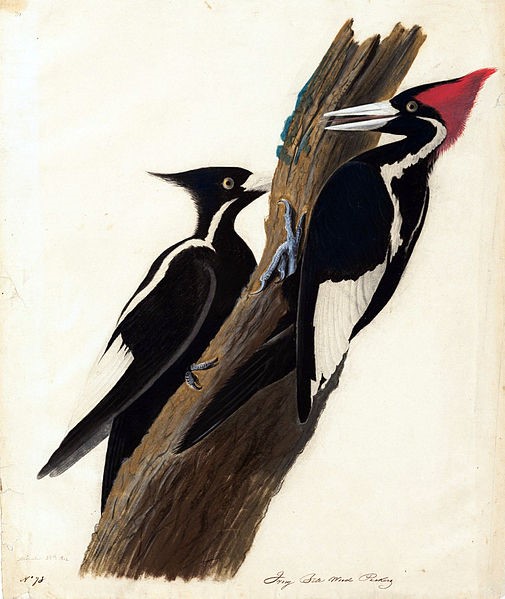The Mystery of the Ivory-Billed Woodpecker

April 3, 2018
The Lord God Bird, Holy Grail Bird, and King of Woodpeckers, are all names for the Ivory-Billed Woodpecker. It is a woodpecker the may live in deep, virtually impenetrable, old-growth swamps and bottomland forests of the southeast. Last definitively seen in the Signer Tract of Louisiana before it was logged in the 1940s, its presence now remains a mystery.
The Ivory-Billed Woodpecker is the largest woodpecker of the United States. It is a black bird with white lines under the wings and has a bright red crest. From a distance though, it is similar to the fairly common Pileated Woodpecker. It is a shy bird because for many years, it was hunted for its ivory bill.
Prior to European colonization, the Ivory-Billed Woodpecker was a widespread but sparsely distributed bird found throughout the Florida and the lower south, up the Mississippi River to southern Illinois. There was also a disjunct population found in Cuba. When the Europeans arrived, they cleared and drained much of the land for agriculture and harvested much of the timber. According to American Forests, four percent of its old growth habitat remains. Most of it is in Arkansas, southern Louisiana and Northwest Florida.
In 2004, after fifteen months of deliberation and review, a sighting was published in the journal Nature. It was apparently seen in the Cache River NWR in Arkansas. Its proof was a video recording. The only problem, it was black and white and was shot at a distance, so a Pileated Woodpecker cannot be ruled out. Afterwards, an extensive search was completed by the Cornell Lab of Ornithology with other local groups that came up empty.
Whether or not it exists, finding it is virtually impossible. It exists in virtually impenetrable forests and it spends much of its time in the upper trunk of trees, out of view from below. According to the Nature Conservatory, a territory needs six square miles of contiguous habitat. This means that in every six miles of the best habitat, there can only be two of this secretive bird. Given these difficulties and the lack of evidence, many people have given up the search. A few people disagree though and are still searching many places like in Arkansas, the Choctawhatchee River in Florida and impenetrable swamps in the Louisiana Delta. There are also many claims by locals that they have found it but no proof. If you are ever in East Arkansas, southern Louisiana or Northwest Florida though, there is a 50,000 reward to anyone who can find conclusive evidence of the existence of the bird.
A Pileated Woodpecker for Comparison


